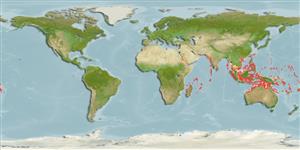>
Gobiiformes (Gobies) >
Gobiidae (Gobies) > Gobiinae
Etymology: Fusigobius: Latin, fusus = spindle + Latin, gobius = gudgeon (Ref. 45335).
More on author: Randall.
Environment: milieu / climate zone / depth range / distribution range
Ecología
marino demersal; rango de profundidad 10 - 48 m (Ref. 41649). Tropical
Indo-West Pacific.
Tamaño / Peso / Age
Maturity: Lm ? range ? - ? cm
Max length : 6.5 cm SL macho / no sexado; (Ref. 41649); 5.4 cm SL (female)
Short description
Claves de identificación | Morfología | Morfometría
Espinas dorsales (total) : 6 - 7; Radios blandos dorsales (total) : 9; Espinas anales: 1; Radios blandos anales: 8. Characterized by semi-translucent grey with numerous small, dusky-edged yellow spots on head, body, caudal and dorsal fins; presence of black spot near margin of first membrane of spinous dorsal fin; fully united pelvic fins; presence of pelvic frenum; rounded caudal fin; longitudinal scale series 26; mainly ctenoid scales including those on side of nape; cycloid scales on breast, base of pectoral fin and anteroventrally on abdomen; scales absent on operculum; absence of median predorsal scales; opening of gill extending to within one-fifth opercle width from posterior edge of preopercle; depth of body 4.6-5.4 in SL (Ref. 90102).
Inhabits sand-rubble bottoms near reefs (Ref. 90102).
Life cycle and mating behavior
Maturities | Reproducción | Spawnings | Egg(s) | Fecundities | Larva
Randall, J.E., 2001. Five new Indo-Pacific gobiid fishes of the genus Coryphopterus. Zool. Stud. 40(3):206-225. (Ref. 41649)
IUCN Red List Status (Ref. 130435)
Threat to humans
Harmless
Human uses
Herramientas
Special reports
Download XML
Fuentes de Internet
Estimates based on models
Preferred temperature (Ref.
123201): 25.8 - 29, mean 28 °C (based on 474 cells).
Phylogenetic diversity index (Ref.
82804): PD
50 = 0.5005 [Uniqueness, from 0.5 = low to 2.0 = high].
Bayesian length-weight: a=0.00708 (0.00333 - 0.01504), b=3.09 (2.92 - 3.26), in cm total length, based on LWR estimates for this (Sub)family-body shape (Ref.
93245).
Nivel trófico (Ref.
69278): 3.3 ±0.3 se; based on size and trophs of closest relatives
Resiliencia (Ref.
120179): Alto, población duplicada en un tiempo mínimo inferior a 15 meses (Preliminary K or Fecundity.).
Fishing Vulnerability (Ref.
59153): Low vulnerability (10 of 100).
